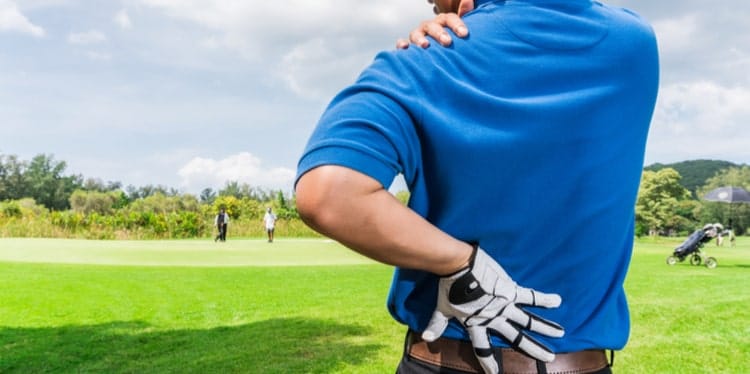
You don’t have to be a professional golfer to suffer from some of the most common injuries in the game. In North Palm Beach, where plenty of amateur and professional golfers like to hit the greens to relax, golf injuries are increasingly common. As an avid player, chances are you’ve already suffered from one or more of these common injuries.
If you’re keen to improve your swing but are trying to avoid the pain that typically comes after, keep on reading. Awareness of possible problems and early treatment is key to making sure you stay on the links.
Of course, stray clubs and errant golf balls are one source of injury while out on the greens. However, it’s more likely that the hours spent bent over your club will you be your true source of pain.
Overuse injuries are common in many sports. However, the repetitive nature of golf makes those who enjoy the sport easily susceptible. The time spent hunched over a golf club perfecting your swing can lead to serious pain in the lower back, shoulder, elbow, and even in the hand. The constant rotational stress placed on the body during a round of golf can lead to a plethora of injuries.
1. Lower Back Strain: Unnatural posture paired with the rotational stress placed onto the back muscles as you swing commonly results in lower back strain. A strain results when the muscles or tendons of the back overstretch or tear. Common symptoms include muscle spasms, localized pain, swelling, and limited flexibility.
2. Golfers’ Elbow Injuries: A golfer will often use an excessive wrist action in their back swing when trying to achieve a greater range of motion. When this happens, there’s a considerable contraction of the forearm flexors, which can cause irritation and inflammation of tendon tissue. When this motion is repeated, it can lead to tendinitis that is commonly referred to as “tennis elbow,” or in the golfing world, “golfer’s elbow.”
3. Wrist and Hand Sprains: The repetitive motions of golf, as well as the high speed of a swing, can place the wrists at high risk of injury. In addition to the stretching or tearing of muscles or tendons, golf frequently results in tendinitis of the wrist or hand.
4. Rotator Cuff Tear or Irritation: Injuries to the rotator cuff are very common, and can be caused by a poorly executed swing, trauma from hitting a rock or other hard object, or simply from overuse. Avid golfers can develop tendinitis, bursitis, or tears in the rotator cuff.
5. Knee Joint Stress: Those already suffering from degenerative diseases like arthritis are likely to experience stress or inflammation in the knees. However, straining the knee to stabilize the rotation of the hip during the beginning of the swing can tear the ligaments or result in pain.
6. Hook of Hamate Fracture: This injury is pretty rare, typically only occurring in golfers. Hitting a large number of balls or repeatedly striking the ground can fracture the hamate bone, one of eight small bones of the wrist. Most of the bone is square shaped. However, there is a small projection on the palm-side of the bone dubbed the “hook of the hamate.” Overuse and trauma can cause the hamate bone to break at the hook.
While you can’t prevent other golfers on the greens from possibly hitting a ball your way, you can work on your own form. To prevent lower back strain, stress in the knee joints, and even rotator cuff injuries, correct form is key. Before you T up, make sure you’re stretching and exercising the muscles of the back regularly. This includes the trapezius and deltoids, which help you follow through with your swing. Flexibility exercises such as yoga can also help to prevent back and shoulder injuries.
Likewise, lacking flexibility in the spine or weak trunk muscles can cause a player to use their arms instead of their core to achieve a longer shot. This can also occur when a golfer attempts to generate momentum by shifting his or her hips backward and then forward in alignment with their swing. Not only can this result in an inconsistent shot, but it can also result in injury in the hips, knees, and wrists.
Before heading out for a round, check out these injury prevention tips:
No golfer is willing to give up their game, and we get that. With the sprawling greens located throughout North Palm Beach, it’s hard to stay away from the course. But, healing any present injuries and building strength is important before throwing that golf bag back over your shoulder. Relief is actually a lot closer than you think.
At ChiroCare, our team of physicians is here to help you strengthen your core, improve your range of motion, and learn to properly stretch before hitting the course. Consistent adjustments can help golfers avoid injuries and reduce pain caused by injuries. Plus, soothing treatments such as ultrasound, and hot laser can target damaged muscles and tendons at the source to help promote healing and relieve discomfort.
If you’re a golfer in North Palm Beach, it’s time to get smart about your swing. Contact ChiroCare today to stay mean on the greens.
